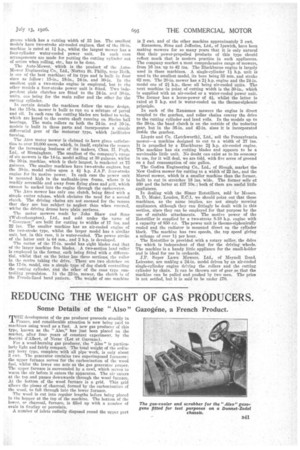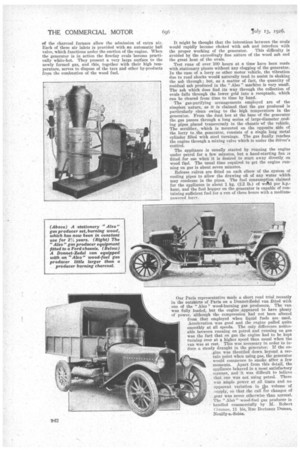REDUCING THE WEIGHT OF GAS PRODUCERS.
Page 25

Page 26

If you've noticed an error in this article please click here to report it so we can fix it.
Some Details of the " Also "
Gazoge-ne, a French Product.
TRE development of the gas producer proceeds steadily in France, and considerable attention is now being paid to machines using wood ,as a;fuel. A new gas producer of this typo, known as the "Also," has just been placed on the market, after four years of constant experiment, by the Societo d'Albert, of Nerac (Lot et Garonne). For a wood-burning gas producer, the "Also" is particularly light and fairly compact. The total weight of the ordinary lorry type, complete with all pipe-work, is only about 3 cwt. The generator contains two superimposed furnaces; the upper furnace serves for the carbonization of the wood fuel, whilst the lower one acts as the gas generator proper. The upper furnace is surrounded by a cowl, which serves to warm the air before it enters the apparatus. The air enters at the top and passes downwards through the wood furnace. At the bottom of the wood furnace is a grid. This grid allows the pieces of charcoal, formed by the carbonization of the wood, to fall through into the lower furnace.
The wood is cut into regular lengths before being placed in the hopper at the top of the machine. The bottom of the lower, or charcoal, furnace, is filled up with a number of ovals in fireclay or porcelain.
A number of inlets radially disposed round the upper part
of the charcoal furnace allow the admission of extra air. Each of these air inlets is provided with an automatic ball valve, which functions under the suction of the engine. When the generator is in action the fireclay ovals become practically white-hot. They present a very large surface to the newly formed gas, and this, together with their high temperature, serves to dispose of the tars and other by-products from the combustion of the wood fuel. It might be thought that the interstices between the ovals would rapidly become choked with ash and interfere with the proper working of the generator. This difficulty is avoided by the exceedingly fine nature of the wood ash and the great heat of the ovals.
Test runs of over 100 hours at a time have been made with stationary plants without any clogging of the generator. In the case of a lorry or other motor vehicle, the vibration due to road shocks would naturally tend to assist in shaking the ash through; but, as a matter of fact, the quantity of residual ash produced in the " Also " machine is very small. The ash which does find its way through the collection of ovals falls through the lower grid into a receptacle, which can be cleared from time to time by hand.
The gas-purifying arrangements employed are of the simplest nature, as it is claimed that the gas produced is particularly clean owing to the high temperature in the generator. From the dust box at the base of the generator the gas passes through a long series of large-diameter ,cooling pipes placed transversely in the chassis of the vehicle. The scrubber, which is mounted on the opposite side of the lorry to the generator, consists of a single long metal cylinder filled with steel turnings. The gas finally reaches the engine through a mixing valve which is under the driver's control.
The appliance is usually started by running the engine under petrol for a few minutes, but a hand-starting fan is fitted for use when it is desired to start away directly, on wood fuel. The usual time required to get the engine running on gas is about seven minutes.
Release valves are fitted on each elbow of the system of cooling pipes to allow the drawing oft of any water which may condense in the pipes. The fuel consumption claimed for the appliance is about 1 kg. (2.2 lb.) of wolbd per h.p.hour, and the fuel hopper on the generator is capable of containing sufficient fuel for a run of three hours with a mediumpowered lorry.
Our Paris representative made a short road trial recently in the outskirts of Paris on a Donnet-Zedel van fitted with one of the " Also " wood-burning gas producers. The van was fully loaded, but the engine Appeared to have plenty of power, although the compression had not been altered from that employed when liquid fuels are used. Acceleration was good and the engine pulled quite smoothly at all speeds. The only difference noticeable between running on petrol and running on gas was the fact that on gas the engine had to be kept turning over at a higher speed than usual when the van was at rest. This was necessary in order to induce a steady draught in the generator. If the en. .gine was throttled down beyond a certain point when using gas, the generator would commence to smoke after a few moments. Apart from this detail, the appliance behaved in a most satisfactory manner, and' it was difficult to believe . that one was not using petrol. There was ample power at all :links and no . apparent venation in _tile volume of supply, so that the call forchanges of : .gear was. never otherwise-than normal. The " Alsai" •wood-fuel gas producer is
• handled commercially by M.. Robert CAzanne, 11 bis,. Rue Derteaux Dumas, Neuilly-s.-Seine.






























